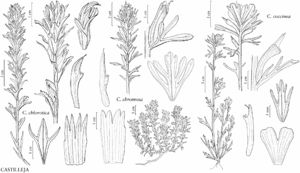Castilleja coccinea
Syst. Veg. 2: 775. 1825.
Herbs, annual or biennial, 1.2–5 (–7) dm; with fibrous-roots. Stems solitary or few, erect to ascending, unbranched, rarely branched, hairs spreading, long, soft, eglandular, others shorter and glandular. Leaves green to sometimes brownish, rosette leaves persisting or withered at anthesis, oblanceolate to oblong-lanceolate, 1–3 cm, usually 0-lobed; cauline leaves linear-lanceolate to oblong-lanceolate, 2–7 (–8) cm, not fleshy, margins plane, sometimes wavy, involute, 3–7 (–9) -lobed, apex acute to acuminate; cauline leaves: lobes spreading to ascending, linear to oblong, (2–) 5–25 mm, apex acuminate. Inflorescences 2–35 (longest in fruit) × 1.5–6 cm; bracts proximally greenish to brownish green, distally red, sometimes orange, yellow, or white, lanceolate to obovate, 3 (–5) -lobed; lobes spreading-ascending, lanceolate and longer on proximal bracts, becoming oblanceolate, shorter, and wider on distal bracts, arising from distal 3/4 of blade, apex acute to rounded. Calyces colored as bracts, 17–23 (–28) mm; abaxial clefts 6–10 mm, adaxial 5–8 mm, clefts 33–50% of calyx length, deeper than laterals, lateral 0–1 mm, 0–5% of calyx length; lobes oblong to triangular, apex rounded to truncate, sometimes emarginate. Corollas straight, 18–31 mm; tube 15–18 mm; abaxial lip ± exserted, beak exserted, often whitish, yellowish, or faint dull reddish proximally, adaxially green distally, 7–10 mm; abaxial lip green to yellowish, apex pink to yellow, reduced, ± protuberant, 1.5–4 mm, 20–33% as long as beak; teeth erect, green or yellow, apices white, yellow, or pink, 2–4 (–5) mm. 2n = 24, 46, 48.
Phenology: Flowering Jan–Sep.
Habitat: Damp or wet meadows, roadsides, prairies, swamps, peatlands, ditches, thickets, dunes, jack pine flats, rocky forests, ledges, sandstone, limestone, or granite.
Elevation: 0–1200 m.
Distribution
Man., Ont., Sask., Ala., Ark., Conn., Del., Fla., Ga., Ill., Ind., Iowa, Kans., Ky., La., Maine, Md., Mass., Mich., Minn., Miss., Mo., N.H., N.J., N.Y., N.C., Ohio, Okla., Pa., R.I., S.C., Tenn., Tex., Va., W.Va., Wis.
Discussion
Castilleja coccinea usually has red bracts. Forms with white or yellow bracts have been named but are scattered across the range of the species. However, yellow-bracted forms become markedly more common in populations in the northern portion of the range, especially in the upper midwestern region. Populations of C. coccinea seem ephemeral, disappearing from one site after a few years and appearing in another. It is rare in much of the eastern portion of its range, and apparently is extirpated in Louisiana, Maine, Massachusetts, and New Hampshire.
Selected References
None.
Lower Taxa
"wider" is not a number."dm" is not declared as a valid unit of measurement for this property.
